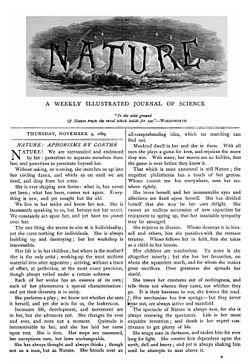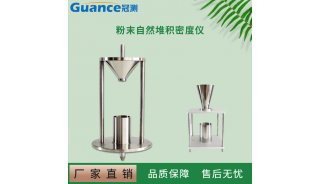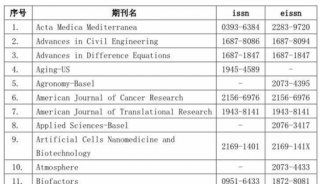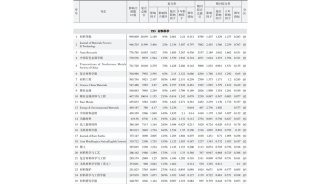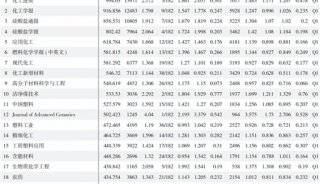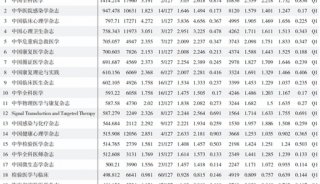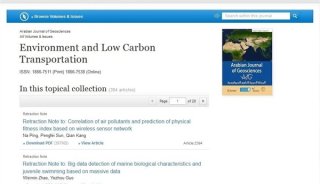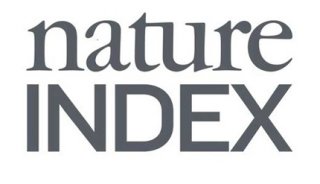英国自然杂志《Nature》介绍
英国自然杂志《Nature》 www.nature.com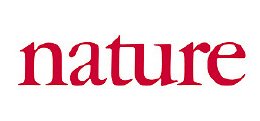
NPG Nature Asia-Pacific www.natureasia.com
出版:英国MacMillan.Ltd
创刊:1869年
刊期:周刊
定位:兼顾学术期刊和科学杂志,即科学论文具较高的新闻性和广泛的读者群。论文不仅要求具有“突出的科学贡献”,还必须“令交叉学科的读者感兴趣”。
自然出版集团出版的Nature系列刊物有三类:
(NaturePublishingGroup)
※综述性期刊,对重要的研究工作进行综述评论;
※ 研究类期刊,以发表原创性研究报告为主;
※临床医学类期刊,对医学领域重要的研究进展做出权威性解释,并促进最新的研究成果转变为临床实践;
英国著名杂志《Nature》是世界上最早的国际性科技期刊,自从1869年创刊以来,始终如一地报道和评论全球科技领域里最重要的突破。影响因子26(04年数据)。其办刊宗旨是“将科学发现的重要结果介绍给公众…,让公众尽早知道全世界自然知识的每一分支中取得的所有进展”。《Nature》网站涵盖的内容相当丰富,不仅提供1997年6月到最新出版的《Nature》杂志的全部内容,其姊妹刊物《Nature》出版集团(The Nature Publishing Group)出版的8种研究月刊,6种评论杂志,2种工具书。
子刊名 IF(2004)
1. Nature Cell Biology 22.122
2. Nature Immunology 27.586
3. Nature Medicine 30.550(03年)
4. Nature Genetics 26.494(03年)
5. Nature Structural & Molecular Biology 12.000
(Nature Structural Biology)
6. Nature Materials 13.531
7. Nature Biotechnology 22.4
8. Nature Chemical Biology (05年创刊)
9. Nature Physics (05年创刊)
10.Nature Neuroscience 16.98
11.Nature Methods (04年创刊)
临床医学类期刊
Nature Clinical Practice Cardiovascular Medicine
Nature Clinical Practice Endocrinology & Metabolism
Nature Clinical Practice Gastroenterology & Hepatology
Nature Clinical Practice Nephrology
Nature Clinical Practice Neurology
Nature Clinical Practice Oncology
Nature Clinical Practice Rheumatology
Nature Clinical Practice Urology
网站:http://www.natureasia.com/
该企业品牌在世界品牌实验室(World Brand Lab)编制的2006年度《世界品牌500强》排行榜中名列第五十四。
目前,nature杂志已有多种播客可以下载
NPG Nature Asia-Pacific www.natureasia.com
鉴于亚太地区近年来研究成果的快速增长,2006年1月份由自然日本公司(Nature Japan K.K.)成立了自然出版集团自然亚太公司(NPG Nature Asia-Pacific)。自然日本公司是1987年在东京成立的,代表自然出版集团(NPG)在亚太地区出版《自然》杂志(Nature)。改名后的公司聚集了来自自然出版集团分布在该地区东京、香港、墨尔本和德里等机构的员工。
自然出版集团自然亚太公司自成立以来规模扩大了三倍以上,到2009年5月员工人数已超过80。凭借自然日本公司强大的销售、市场推广及编辑力量,我们出版了几个新刊物,它们既代表自然出版集团各种不同的出版业务,又代表自然出版集团自然亚太公司所特有的新业务。
2007年1月创刊的《自然光子学》杂志(Nature Photonics)是自然出版集团最新学术刊物之一,其核心编辑团队、包括编辑制作团队在东京,而分项编辑业务则在伦敦。在此之前,《自然》系列的所有学术刊物都是在英国或美国出版的。
《自然光子学》的核心团队之所以设在东京,是因为日本及相邻亚洲地区企业及学术机构在光子学领域的研究力量在迅速发展。基于类似的原因,我们为在东京出版的《自然纳米技术》杂志(Nature Nanotechnology)(2006年10月创刊)任命了一位讲汉语的编辑和一位讲日语的顾问编辑。
《自然光子学》和《自然纳米技术》的编辑们正在与整个亚太地区的研究人员建立联系,鼓励他们向其刊物投稿一流研究论文;让亚太地区更多研究人员参与投到他们刊物的文章的审稿工作;同时去发现在当地刊物上所发表的及在当地会议上所提交的一些最好的研究工作,以便在《自然光子学》和《自然纳米技术》上介绍其主要内容。
除了其自己的《自然》品牌的刊物外,自然出版集团还代表各种不同的学术性学会及机构出版很多刊物。不久前,所有这些刊物的编辑部都是设在欧洲或美国。自然出版集团自然亚太公司已开始在亚太地区执行一项新的学术刊物出版计划,该计划由墨尔本的一位副出版人(associate publisher)来运作,由在东京的自然出版集团亚太区副总监(Asia-Pacific Associate Director of NPG)来监督,由两地的工作人员提供支持。
中国影响因子最高的刊物《细胞研究》杂志(Cell Research)率先于2006年1月加入该计划;紧随其后的是澳大利亚和新西兰的《免疫学与细胞生物学》杂志(Immunology and Cell Biology),,它们于2007年1月加入该计划;从2009年1月起加入该计划的有来自日本的《人类遗传学》杂志(Journal of Human Genetics)、《高血压研究》杂志(Hypertension Research)和《抗菌素杂志》(Journal of Antibiotics);来自中国的《中国药理学报》(Acta Pharmacoligica Sinica)和《亚洲男科学杂志》(Asian Journal of Andrology)。除这7个杂志外,从2010年1月开始,日本的《高分子杂志》(Polymer Journal)(请阅读“《高分子杂志》新闻稿”)和中国的《细胞与分子免疫学》杂志(Cellular and Molecular Immunology)也将加入该计划。
该计划的目的是,选择该地区一些最好的刊物,与它们共同努力,来增强其质量和影响。我们可以通过利用自然出版集团的编辑和出版专长以及在《自然》杂志强大的网站 nature.com 上托管这些刊物来实现这一目的。该网站每月下载量近5000万页。
自然出版集团自然亚太公司2006年率先实施了由自然出版集团发起的医学传播领域的一个新项目,即Macmillan Medical Communications (MMC)(麦克米兰医学传播),是按自然出版集团所归属的麦克米兰出版公司(Macmillan Publishers Ltd.)命名的。
MMC以东京为基地的业务正在迅速发展,并且在自2006年7月启动后的第一个完整运营年份就实现了赢利。
MMC是一个战略性的医学传播机构,为在制药及医疗保健领域的合作伙伴提供量身定制的产品和服务,并且能够借助自然出版集团高质量医学内容的力量。
MMC的业务活动包括出版由制药公司赞助的自然出版集团医学刊物的翻译版,免费向医学界发放,以及为制药及医疗保健行业提供量身定制的产品和服务。
继MMC业务在东京获得成功之后,2007年7月我们又在马德里创建了MMC的一个新的分支机构,用欧洲及拉丁美洲的本地语言开展医学传播业务。
由自然出版集团自然亚太公司首先进行的另一项业务是,为该地区的高等院校及研究机构提供量身定制的出版服务。虽然来自亚太地区的研究工作的数量及质量近年来都有极大提高,但全球科学界对该地区领先研究团体及研究机构的了解程度仍然比较低。从2009年4月开始,这些定制出版服务已由自然出版集团一个新成立的部门负责,该部门名叫“麦克米兰科学传播公司”(MSC)。
设在东京的MSC目前正在与亚太地区各学术机构及研究团体合作创办印刷版本及在线版本的出版物,旨在通过利用自然出版集团在出版、编辑和市场推广方面的技能来提高人们对该地区最好的研究工作的认识和了解。这项服务的第一个例子是2006年6月代表日本理化学研究所(RIKEN)创刊的RIKEN RESEARCH,这个研究所是日本领先的研究机构之一。2007年12月,由自然出版集团自然亚太公司和“亚太国际分子生物学网络”(A-IMBN)联合创建的一个网站在natureasia.com上开通。这个网站名为A-IMBN Research,重点介绍由A-IMBN的大约300名会员及18个会员机构所发表的一些最好的研究工作。因亚太地区不同研究所和机构的支持, A-IMBN Research可以让读者免费访问。
2008年4月,我们与东京工业大学推出了NPG Asia Materials,重点介绍本地区最好的一些材料研究成果。
与此同时,自然出版集团自然亚太公司还与该集团伦敦总部及在美国的网站团队合作创建了Nature China,这是一个托管在nature.com上的网站,重点介绍由中国大陆及香港的研究人员所发表的一些最好的研究工作。Nature China 由自然出版集团自然亚太公司香港办事处管理。同样,Nature India网站也于2008年1月开通,在德里运行。
通过大量这样的活动,自然出版集团自然亚太公司正在帮助迅速提高亚太地区最好研究工作的显示度和知名度。
这些新的出版活动建立在自然出版集团自然亚太公司持续增长的销售力量之上,它们使该地区的研究机构及研究人员能够看到自然出版集团所属刊物的电子版本及印刷版本,并且还为在自然出版集团印刷版和网络版的出版物上做广告提供了机会。
Nature is one of the world's most prestigious scientific journals, first published on 4 November 1869. It is the world's most cited interdisciplinary science journal.[1] Most scientific journals are now highly specialized, andNature is among the few journals (the other weekly journals Science and Proceedings of the National Academy of Sciences are also prominent examples) that still publish original research articles across a wide range of scientific fields. There are many fields of scientific research in which important new advances and original research are published as either articles or letters in Nature.
Research scientists are the primary audience for the journal, but summaries and accompanying articles are intended to make many of the most important papers understandable to scientists in other fields and the educated general public. Towards the front of each issue are editorials, news and feature articles on issues of general interest to scientists, including current affairs, science funding, business, scientific ethics and research breakthroughs. There are also sections on books and arts. The remainder of the journal consists mostly of research articles, which are often dense and highly technical. Because of strict limits on the length of articles, often the printed text is actually a summary of the work in question with many details relegated to accompanyingsupplementary material on the journal's website.
In 2007 Nature (together with Science) received the Prince of Asturias Award for Communications and Humanity.[
Scientific magazines and journals preceding Nature
Nineteenth-century Britain was home to a great deal of scientific progress; particularly in the latter half of the 19th century, Britain underwent enormous technological and industrial changes and advances.[3] The most respected scientific journals of this time were the refereed journals of the Royal Society, which had published many of the great works from Isaac Newton, Michael Faraday through to early works from Charles Darwin. In addition, during this period, the number of popular science periodicals doubled from the 1850s to the 1860s.[4] According to the editors of these popular science magazines, the publications were designed to serve as “organs of science,” in essence, a means of connecting the public to the scientific world.[4]
Nature, first created in 1869, was not the first magazine of its kind. One journal to precede Nature was titled Recreative Science: A Record and Remembrancer of Intellectual Observation, which, created in 1859, began as a natural history magazine and progressed to include more physical observational science and technical subjects and less natural history.[5] The journal’s name changed from its original title to Intellectual Observer: A Review of Natural History, Microscopic Research, and Recreative Scienceand then later to the Student and Intellectual Observer of Science, Literature, and Art.[6] While Recreative Science had attempted to include more physical sciences such as astronomy and archaeology, the Intellectual Observer broadened itself further to include literature and art as well.[6] Similar to Recreative Science was the scientific journal titled Popular Science Review, created in 1862,[7] which covered different fields of science by creating subsections titled ‘Scientific Summary’ or ‘Quarterly Retrospect,’ with book reviews and commentary on the latest scientific works and publications.[7] Two other journals produced in England prior to the development of Nature were titled the Quarterly Journal of Science and Scientific Opinion, founded in 1864 and 1868, respectively.[6] The journal most closely related to Nature in its editorship and format was titled The Reader, created in 1864; the publication mixed science with literature and art in an attempt to reach an audience outside of the scientific community, similar to Popular Science Review.[6]
These similar journals all ultimately failed. The Popular Science Review was the longest to survive, lasting 20 years and ending its publication in 1881; Recreative Science ceased publication as the Student and Intellectual Observer in 1871. The Quarterly Journal, after undergoing a number of editorial changes, ceased publication in 1885. The Reader terminated in 1867, and finally, Scientific Opinion lasted a mere 2 years, until June 1870.[5]
[edit] The creation of Nature
Not long after the conclusion of The Reader, a former editor, Norman Lockyer, decided to create a new scientific journal titledNature,[8] taking its name from a line by William Wordsworth: "To the solid ground of nature trusts the Mind that builds for aye".[9] First owned and published by Alexander Macmillan, Nature was similar to its predecessors in its attempt to “provide cultivated readers with an accessible forum for reading about advances in scientific knowledge.”[8] Janet Browne has proposed that “far more than any other science journal of the period, Nature was conceived, born, and raised to serve polemic purpose.”[8] Many of the early editions of Nature consisted of articles written by members of a group that called itself the X Club, a group of scientists known for having liberal, progressive, and somewhat controversial scientific beliefs relative to the time period.[8] Initiated by Thomas Henry Huxley, the group consisted of such important scientists as Joseph Dalton Hooker, Herbert Spencer, and John Tyndall, along with another five scientists and mathematicians; these scientists were all avid supporters of Darwin’s theory of evolution as common descent, a theory which, during the latter-half of the 19th century, received a great deal of criticism among more conservative groups of scientists.[10] Perhaps it was in part its scientific liberality that made Naturea longer-lasting success than its predecessors. John Maddox, editor of Nature from 1966 to 1973 as well as from 1980 to 1995, suggested at a celebratory dinner for the journal’s centennial edition that perhaps it was the journalistic qualities of Nature that drew readers in; “journalism” Maddox states, “is a way of creating a sense of community among people who would otherwise be isolated from each other. This is what Lockyer’s journal did from the start.”[11] In addition, Maddox mentions that the financial backing of the journal in its first years by the Macmillan family also allowed the journal to flourish and develop more freely than scientific journals before it.[11]
[edit] Nature in the 20th and early 21st centuries
Nature underwent a great deal of development and expansion during the 20th century, particularly during the latter half of the 90s.
[edit] Editors
Norman Lockyer, the founder of Nature, was a professor at Imperial College. He was succeeded in 1919 by Richard Gregory, the second editor of the journal.[12] Gregory helped to establish Nature in the international scientific community. His obituary by the Royal Society stated: "Gregory was always very interested in the international contacts of science, and in the columns of Naturehe always gave generous space to accounts of the activities of the International Scientific Unions."[13] During the years 1945 to 1973, editorship of Nature changed three times, first in 1945 to A.J.V. Gale and L.J.F. Brimble (who in 1958 became the sole editor), then to John Maddox in 1965, and finally to David Davies in 1973.[12] In 1980, Maddox returned as editor and retained his position until 1995. Philip Campbell has since become Editor-in-chief of all Nature publications.[12]
[edit] Nature’s expansion and development
In 1970, Nature first opened its Washington office; other branches opened in New York in 1985, Tokyo and Munich in 1987, Paris in 1989, San Francisco in 2001, Boston in 2004, and Hong Kong in 2005. Starting in the 1980s, the journal underwent a great deal of expansion, launching over ten new journals. These new journals comprise the Nature Publishing Group, which was created in 1999 and includes Nature, Nature Research Journals, Stockton Press Specialist Journals and Macmillan Reference (renamed NPG Reference).
In 1997, Nature created its own website, www.nature.com, and in 1999 Nature Publishing Group began its series of Nature Reviews.[12] Some articles and papers are available for free on the Nature Web site. Others require the purchase of premium access to the site.
Nature claims a readership of about 424,000 total readers. The journal has a circulation of around 53,000 but studies have concluded that on average a single copy is shared by as many as 8 people.[14]
On 30 October 2008, Nature endorsed an American presidential candidate for the first time when it supported Barack Obamaduring his campaign in America's 2008 presidential election.[15][16]
[edit] Publishing in Nature
Having an article published in Nature is very prestigious, and the articles are often highly cited, which can lead to promotions, grant funding, and attention from the mainstream media. Because of these positive feedback effects, competition among scientists to publish in high-level journals like Nature and its closest competitor, Science, can be very fierce. Nature's impact factor, a measure of how many citations a journal generates in other works, was 34.480 in 2009 (as measured by Thomson ISI), among the highest of any science journal.
As with most other professional scientific journals, articles undergo an initial screening by the editor, followed by peer review (in which other scientists, chosen by the editor for expertise with the subject matter but who have no connection to the research under review, will read and critique articles), before publication. In the case of Nature, they are only sent for review if it is decided that they deal with a topical subject and are sufficiently ground-breaking in that particular field. As a consequence, the majority of submitted articles are rejected without review.
According to Nature's original mission statement:
It is intended, FIRST, to place before the general public the grand results of Scientific Work and Scientific Discovery; and to urge the claims of Science to a more general recognition in Education and in Daily Life; and, SECONDLY, to aid Scientific men themselves, by giving early information of all advances made in any branch of Natural knowledge throughout the world, and by affording them an opportunity of discussing the various Scientific questions which arise from time to time.—20, 20






